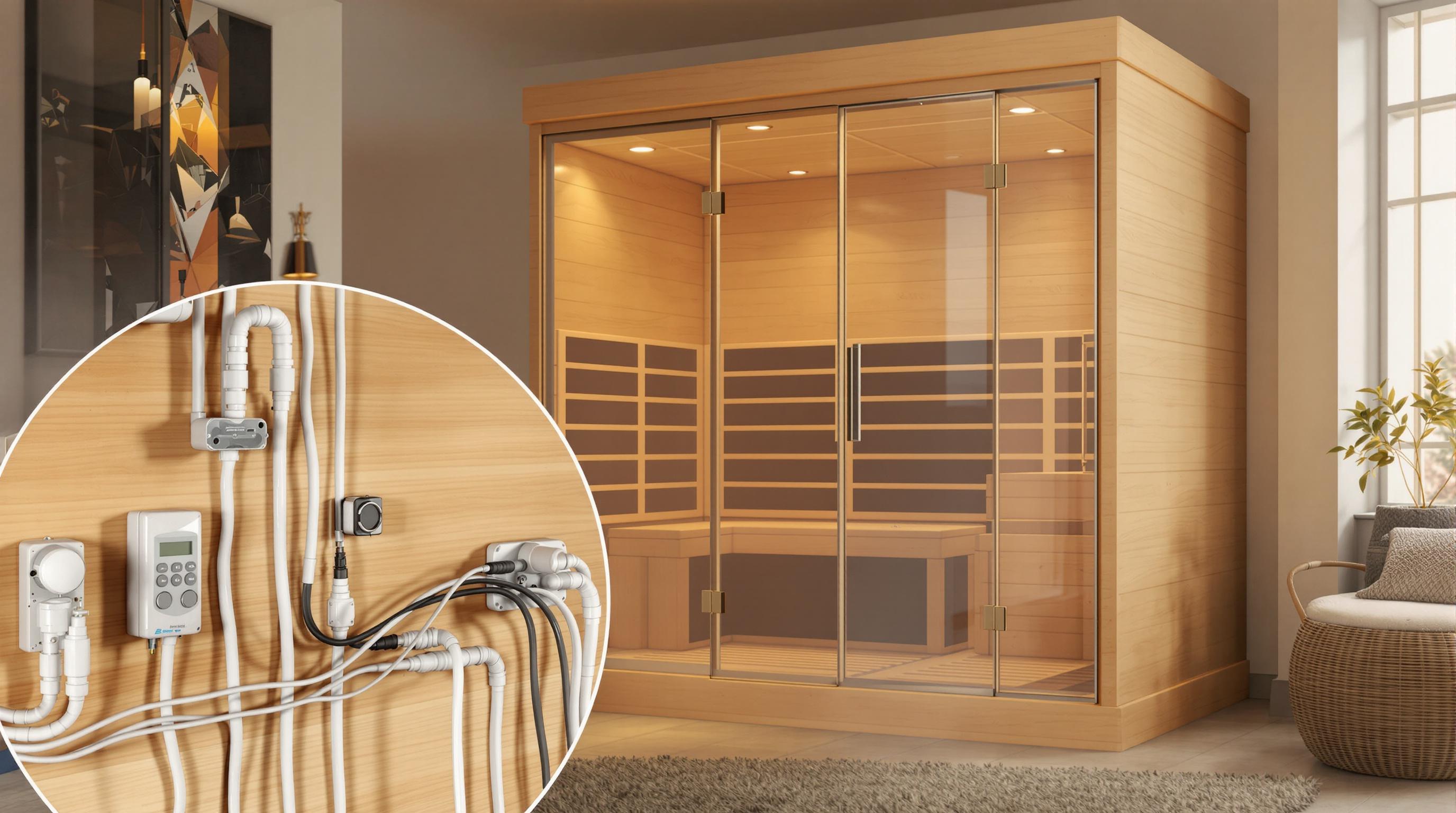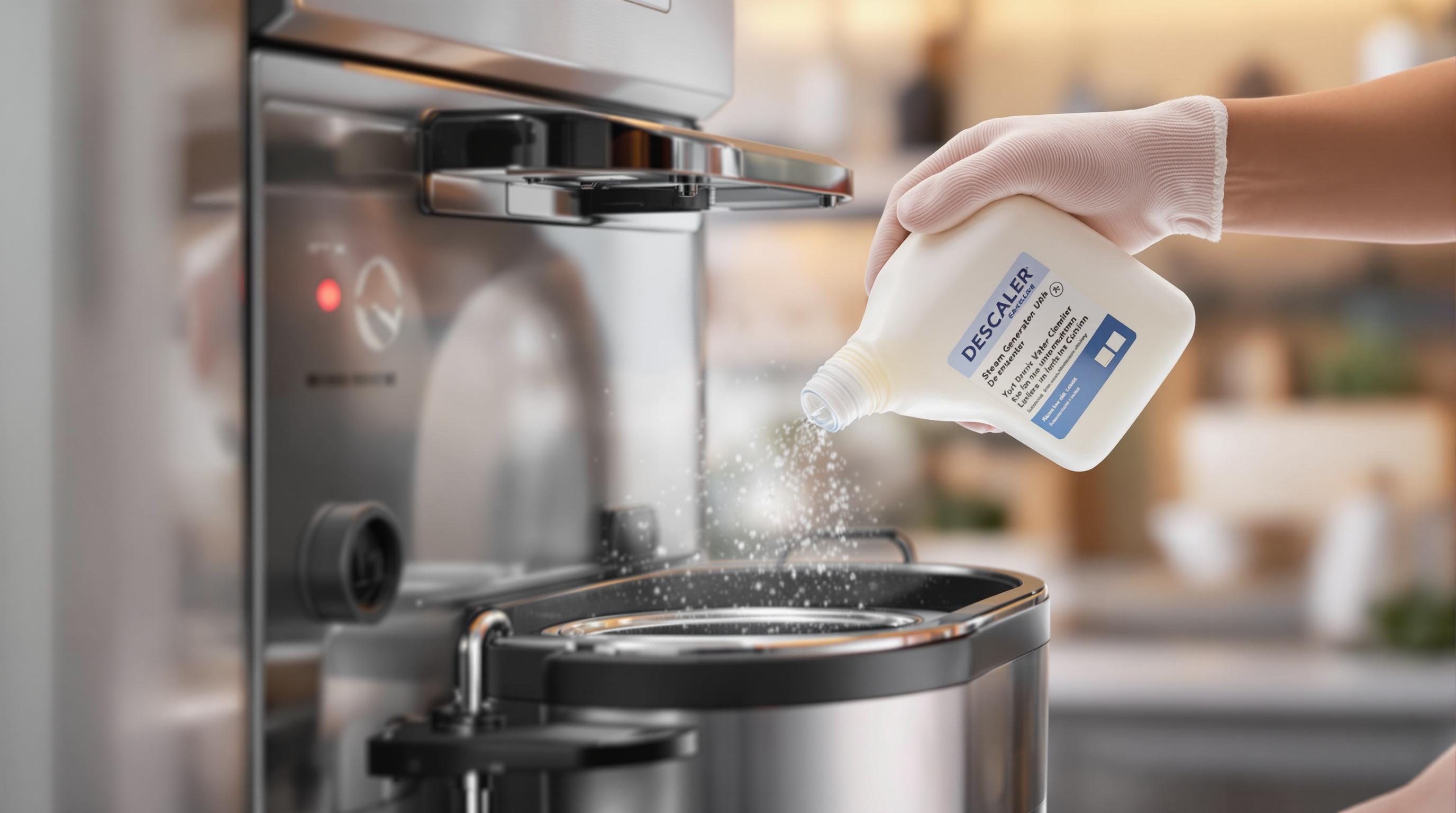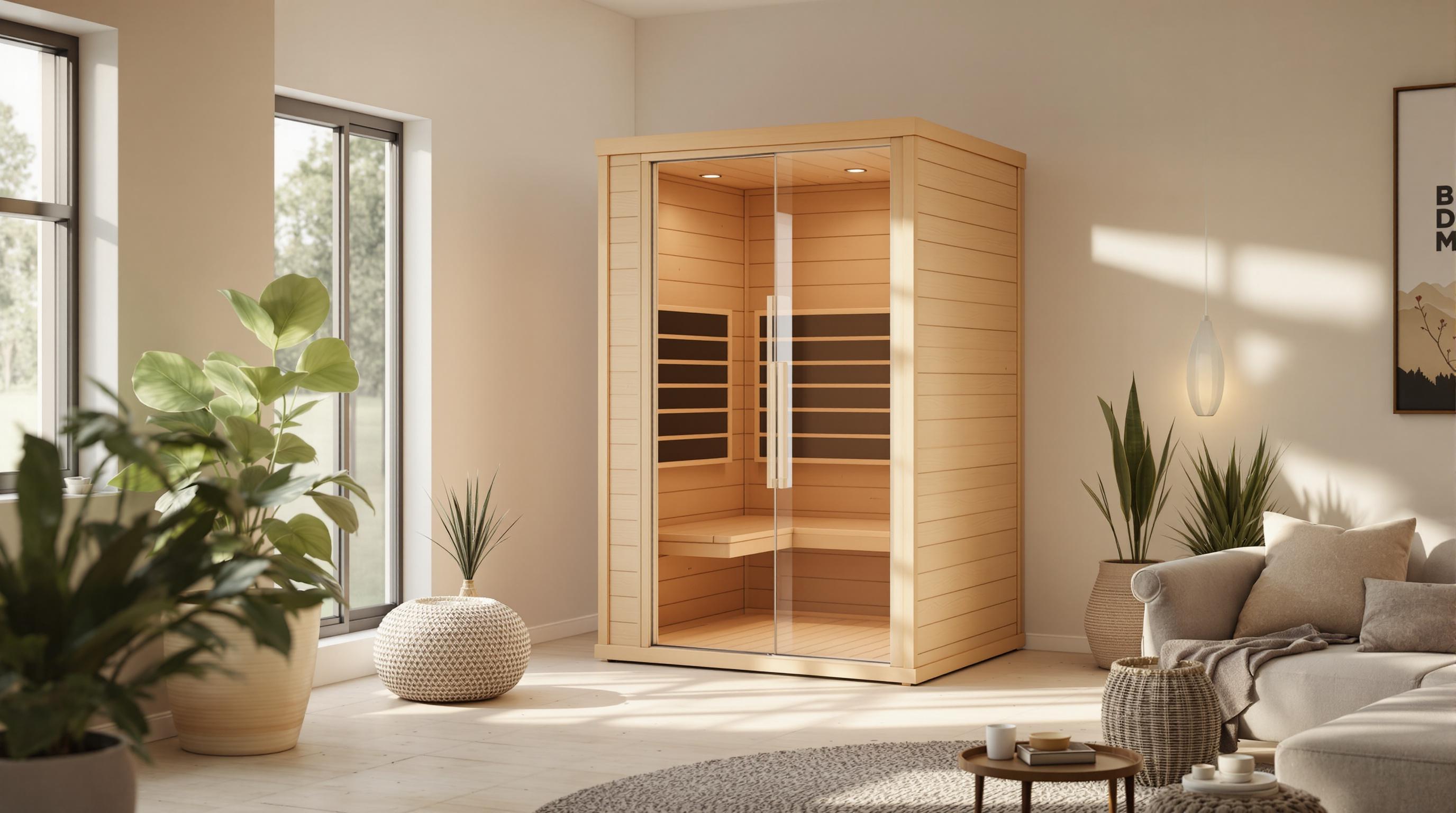Looking for the safest wood for your sauna? Here's a quick guide to the 5 best non-toxic sauna woods: Aspen, Basswood, Nordic Spruce, Hemlock, and Poplar. These woods are safe, durable, and perfect for high-heat, humid environments.
Key Features of Each Wood:
- Aspen: Hypoallergenic, resists heat and moisture, and stays bright.
- Basswood: Resin-free, allergy-friendly, and stable under heat.
- Nordic Spruce: Durable, retains heat well, and eco-friendly.
- Hemlock: Affordable, resists warping, and has a clean look.
- Poplar: Budget-friendly, smooth texture, and low VOC emissions.
Quick Comparison Table:
| Wood Type | Hypoallergenic | Heat Resistance | Moisture Resistance | Cost |
|---|---|---|---|---|
| Aspen | Yes | Excellent | High | Mid-Range |
| Basswood | Yes | Good | High | Medium |
| Nordic Spruce | Yes | Very Good | Excellent | Mid-Range |
| Hemlock | Moderate | Good | Moderate | Affordable |
| Poplar | Yes | Moderate | Moderate | Budget-Friendly |
Choose based on your priorities: allergy safety, heat performance, or budget. Read on for detailed comparisons and maintenance tips.
1. Aspen
Gentle on Skin and Safe for Allergies
Aspen is a great option for those who are sensitive to allergens. Its low sap content and naturally smooth surface make it less likely to irritate the skin. Plus, its fine fiber structure keeps the wood free of rough burrs that could cause discomfort [2][3].
Built to Handle High Heat
Aspen holds up well under the intense conditions of a sauna. It keeps its shape and doesn’t warp or break down, even with prolonged exposure to high temperatures [2][4]. When treated through a process called Thermally Modified Aspen (TMA), its durability gets even better, thanks to a controlled heat treatment [1].
"The thermal modification process reduces the wood's moisture content to 0% over 35-46 hours, resulting in up to 30% better heat and sound insulation compared to natural wood" [1].
Fights Moisture, Stays Bright
Saunas are humid spaces, but aspen is naturally resistant to moisture. This quality helps prevent mold and mildew, keeping your sauna cleaner and safer [2][4]. Its pale color also stays bright, adding a fresh look to the sauna interior.
| Property | Aspen | TMA Aspen |
|---|---|---|
| Heat Insulation | Good | Superior (30% better) |
| Dimensional Stability | Standard | Enhanced |
| Biological Resistance | Moderate | Improved |
| Maintenance Needs | Regular | Minimal |
Thanks to its ability to handle heat and resist moisture, aspen is a top choice for saunas. Up next, we’ll look at how basswood compares in thermal stability.
2. Basswood
Gentle on Skin and Allergy-Friendly
Basswood, much like aspen, is an excellent choice for those seeking an allergy-friendly wood. Its extremely low resin and oil content reduces the risk of VOC emissions and allergic reactions. Plus, its smooth surface feels soft and gentle against the skin, making it a comfortable option for sauna use [1][3].
Handles Heat with Ease
Basswood performs well under the high temperatures of a sauna. Unlike some woods that may release unpleasant odors or harmful substances when heated, basswood stays stable and maintains its chemical neutrality. This makes it a reliable option for long-term sauna use [1][3].
Resists Moisture and Mold
Saunas are humid environments, but basswood is up to the challenge. Its low resin content helps prevent the growth of mildew and mold, ensuring a cleaner and healthier space. This natural resistance makes it a practical and hygienic choice for sauna interiors [1][3].
| Property | Benefit |
|---|---|
| Low Resin Content | Minimizes allergen exposure |
| Smooth Texture | Comfortable for skin contact |
| Moisture Resistance | Helps prevent mold growth |
| Heat Stability | Durable under high heat |
To keep basswood in top condition, apply paraffin oil periodically and clean it with mild detergents. This simple care routine helps maintain its safety, comfort, and appearance [1].
"Basswood's smooth texture, low resin content, and natural resistance to moisture contribute to a comfortable and safe sauna experience, reducing the risk of allergic reactions and ensuring a pleasant environment" [1][3].
While basswood is a standout for its hypoallergenic features, the next section explores Nordic Spruce, which brings its own strengths in heat retention and efficiency.
Sauna Wood Masterclass: Everything You Need to Know About Safe Wood Selection
3. Nordic Spruce
Nordic Spruce is a popular choice for saunas thanks to its low resin content and dense structure, which make it a safe and durable option. Like basswood and aspen, it’s particularly suitable for those with sensitivities [4].
Durability in High-Heat Conditions
This wood’s dense structure allows it to perform well under high temperatures. Its tight growth rings not only enhance heat stability but also minimize the risk of warping when exposed to heat stress [4].
| Property | Benefit |
|---|---|
| Dense Structure | Stability in extreme heat |
| Tight Growth Rings | Better heat distribution |
| Low Thermal Conductivity | Retains heat efficiently |
| Natural Durability | Long-lasting in sauna environments |
Resistance to Moisture
Nordic Spruce is excellent at resisting moisture, a key feature for sauna longevity. Its natural structure and low thermal conductivity help limit moisture absorption, reducing the risk of issues like warping or mold [4].
"Nordic Spruce's exceptional combination of moisture resistance and thermal properties makes it a reliable choice for sauna construction, ensuring consistent performance and durability in demanding environments" [4].
Its ability to handle humidity effectively, combined with its eco-friendly credentials, makes it a standout material for modern saunas.
Eco-Friendly Sourcing
Nordic Spruce grows quickly in managed forests, making it a sustainable option for sauna construction [4]. This aligns with the increasing demand for responsibly sourced materials.
To get the best results with Nordic Spruce, ensure proper ventilation during installation. Regular cleaning with mild products will help maintain its natural properties and prolong its lifespan [4].
sbb-itb-3953eb0
4. Hemlock
Hemlock stands out for its low resin levels and minimal VOC emissions, making it a safer option for individuals sensitive to allergens. Its dense structure also ensures excellent heat retention, similar to aspen and basswood [1].
Performance in High Temperatures
Hemlock's dense structure, comparable to Nordic Spruce, makes it well-suited for high-temperature settings. This natural composition offers several advantages:
| Property | Advantage |
|---|---|
| Dense Structure | Retains heat effectively |
| Heat Stability | Maintains consistent temperatures |
| Reduced Heat Loss | Helps lower energy consumption |
| Structural Integrity | Resists warping under heat stress |
Resistance to Moisture
Hemlock naturally resists moisture, making it a practical choice for the humid environment of saunas [1].
"Regular cleaning with mild detergents, preventive care such as placing towels on benches, and ensuring proper ventilation between sessions are essential maintenance practices for Hemlock wood saunas. These practices help maintain the wood's appearance and structural integrity over time" [1].
Visual Appeal
With its light, creamy white-to-brown tones and straight grain, Hemlock offers a clean, modern look while maintaining its practicality [1].
Up next, we’ll explore Poplar and how it combines affordability with safety.
5. Poplar
Poplar wraps up our list as a budget-friendly option that still meets essential safety standards. Thanks to its low resin content and smooth texture, it’s a reliable choice for high-temperature settings.
Skin-Friendly and Non-Toxic Features
Poplar is a safer option for those who prioritize air quality and skin comfort. Here’s why:
| Feature | Advantage |
|---|---|
| Low Resin Content | Reduces chances of allergic reactions |
| Minimal VOC Emissions | Promotes a healthier sauna atmosphere |
| Smooth Surface | Prevents skin irritation |
| Natural Composition | Supports clean indoor air |
Performance in High-Temperature Settings
Poplar holds up well under heat, maintaining its structure when installed and treated properly. While it performs reliably, careful attention to its preparation and maintenance can help extend its lifespan in demanding environments.
Handling Humidity
Poplar deals with humidity reasonably well, similar to Hemlock. Thermal treatment can further boost its ability to resist moisture. To keep your Poplar sauna in top shape, follow these tips:
| Maintenance Tip | What to Do |
|---|---|
| Ventilation | Allow for good airflow between sauna sessions |
| Surface Care | Use protective natural oils |
| Installation | Opt for moisture-resistant fasteners |
| Inspections | Regularly check for signs of warping or discoloration |
Eco-Friendly Appeal
Poplar isn’t just practical - it’s also a responsible choice. Its fast-growing nature makes it a sustainable option for sauna projects. FSC-certified Poplar aligns with environmentally conscious building practices, making it a smart pick for those on a budget who care about eco-friendly construction.
Choosing Sauna Wood: Key Factors
When selecting wood for your sauna, several factors play a crucial role in ensuring safety and performance. These considerations stem from the unique characteristics of different wood types, helping you focus on what matters most.
Durability and Heat Resistance
Sauna wood must handle constant temperature changes without degrading. Here's a quick look at how popular wood types hold up under heat:
| Wood Type | Heat Resistance | Performance Rating |
|---|---|---|
| Aspen | Excellent | High |
| Nordic Spruce | Very Good | High |
| Hemlock | Good | Medium-High |
| Basswood | Good | Medium |
Moisture Management
Managing moisture is critical for avoiding mold and maintaining the sauna's structure. Nordic spruce and thermally treated aspen are top performers in this category [1][6].
| Feature | Importance in Saunas |
|---|---|
| Water Absorption Rate | Impacts drying efficiency |
| Dimensional Stability | Reduces warping risks |
| Mold Resistance | Keeps air quality intact |
Health and Safety Considerations
If you or your guests have sensitivities, choosing hypoallergenic wood is essential. Aspen and basswood are excellent choices due to their low resin content, making them suitable for those with allergies or respiratory issues [2][3].
Budget and Sustainability
For eco-conscious buyers, sustainably sourced wood is a key consideration. Look for certifications like FSC and PEFC to ensure responsible forestry practices.
| Certification | Purpose |
|---|---|
| FSC | Verifies sustainable harvesting |
| PEFC | Promotes responsible forestry |
Balancing cost and performance is also important. Some woods offer premium features, but there are affordable options that still perform well:
| Price Range | Wood Types | Key Features |
|---|---|---|
| Mid-Range | Nordic Spruce, Aspen | Great mix of durability and cost |
| Budget-Friendly | Hemlock, Poplar | Solid performance at lower cost |
For a deeper dive into how these woods perform in actual sauna settings, check out expert resources tailored to your specific needs.
Conclusion
Choosing the right sauna wood is key to ensuring safe heat exposure and durability. Each wood type has its own strengths, making it easier to align with your specific needs.
Here’s a quick comparison:
| Wood Type | Key Benefit |
|---|---|
| Aspen | Great heat insulation, no chemical treatments |
| Basswood | Minimal allergen risk |
| Nordic Spruce | Excellent moisture resistance |
| Hemlock | Balanced cost and durability |
| Poplar | Budget-friendly and environmentally conscious |
When deciding, think about:
- Maintenance: Follow care instructions for each wood type to keep it in top condition.
- Health Considerations: Hypoallergenic woods are ideal for users with sensitivities.
- Budget: Weigh upfront costs against how long the wood will last.
For expert advice on pairing these woods with specific sauna models, check out Find the Home Sauna of Your Dreams.
FAQs
Which wood is best for a sauna?
The best wood depends on your specific needs:
- Nordic Spruce is a top pick for traditional saunas. Its tight growth rings help distribute heat evenly and reduce the risk of warping. This wood also retains heat well and resists steam, making it ideal for maintaining steady sauna temperatures [1][6].
- Aspen is known for its hypoallergenic properties and excellent heat insulation, making it a great choice for many users [2].
For those with allergies or respiratory sensitivities, Basswood is an excellent option. It’s resin-free and doesn’t release VOCs, making it suitable for individuals with specific health concerns [3].
Which is better: hemlock or poplar sauna?
The choice between hemlock and poplar depends on your priorities, such as health needs and budget:
-
Poplar is the better option if you:
- Have chemical sensitivities
- Need a wood that is free of harmful chemicals
- Want the most hypoallergenic material available
-
Hemlock is a great choice if you’re looking for:
- A more affordable option
- Strong durability
- Resistance to warping and shrinkage [5]
For detailed care instructions, refer to the maintenance tables for Hemlock and Poplar in Sections 4 and 5.


